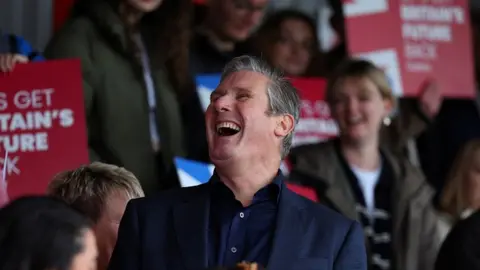By-elections: Is it back to the 1990s for Keir Starmer's Labour?
 Reuters
ReutersI type these words having just wandered across Tamworth FC's artificial grass pitch, amid the red placards and cheering smiles of a second Labour victory rally in just one morning.
Yes, governments often get a kicking in by-elections.
But where these two Labour victories happened - and the kind of numbers involved - are worth a closer look.
As I wrote the other day, this corner of Staffordshire has a rich political history.
In 1996, a similar seat, including Tamworth, had a by-election. Labour took it from the Conservatives with a 22% swing.
A year later, Labour - or New Labour as it had been rebranded by leader Tony Blair - won a landslide general election victory.
Brian Jenkins, who won that by-election in 1996, was in the stands this morning, cheering Keir Starmer and Sarah Edwards, the town's new Labour MP.
Ms Edwards won on a colossal 23.9% swing from the Conservatives to Labour.
 Getty Images
Getty ImagesIn Mid Bedfordshire, Labour won with a swing of 20.5%, overturning a 24,664 vote Conservative majority - the largest such reversal in by-election history.
Sir Keir told me he'd allowed himself a jig around his front room in the middle of the night when the results came in.
At his first victory rally of the morning, in Marston Moretaine near Bedford, the red placards and Labour smiles amid the greenery of the Home Counties were quite a spectacle.
Even the place names sound double-barrelled here.
As he addressed activists, Sir Keir seemed to say the word "change" in every other sentence. Victories like these proved Labour could now win anywhere, he told them.
The swing in Mid Beds was almost identical to the 20.4% Labour managed from the Scottish National Party in Rutherglen and Hamilton West a couple of weeks ago.
It was similar too in Selby and Ainsty in North Yorkshire in the summer.
The only recent exception to this trend was Uxbridge and South Ruislip, where Labour failed to take the seat on a more modest seven point swing, as a row raged over the London Labour Mayor's Ultra Low Emissions Zone (Ulez).
The parallels with the 1990s are clear - 20% by-election swings, a Conservative Party trailing badly in the polls, beset by angst and bickering after more than a decade in government.
(And talking of angst, my WhatsApps contain some spiky private reflections from Conservatives about their prospects in next year's general election. "Annihilation" is one such fear.)
But there are two very big reasons why things in the 2020s are very different from the 1990s.
One is economic. The other is political.
By the time of the 1997 general election, despite plenty of turmoil earlier in the decade, the economic backdrop was benign - the economy was growing.
Things are rather different now: the economy has been flatlining and the tax burden is at a record modern high.
Politically, Labour was starting from a much stronger position in the 1997 general election, having closed the gap on the Tories at the previous general election.
Labour's performance in the 2019 general election was their worst since 1935, leaving them with a colossal mountain to climb to even win a very small majority to call their own.
Keir Starmer needs a bigger swing than Tony Blair managed in 1997 to gain the keys to Downing Street.
Not as big a swing as he has managed in some of these by-elections. But by-elections are not general elections, and plenty on all sides expect the opinion polls to tighten.
All that said, days like this explain why Labour now believe they can actually win and even more Conservatives are increasingly resigned to being doomed.
